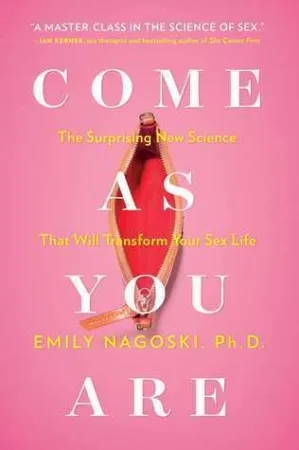Come as You Are Book Summary

Surprising New Science
Emily Nagoski’s 2015 bestselling self-help book Come As You Are, with a tagline that literally says The Surprising New Science That Will Transform Your Sex Life, deals with female sexuality and claims to do away with common misconceptions. It thoroughly explores the ideas of desire, arousal, and pleasure with the help of extensive scientific research and case studies of people who have come to the author to seek help to enhance their intimate encounters satisfactorily.
The Drive Myth
Nagoski begins her book by dispelling popular myths that often disregard female sexuality. She particularly picks up the one that tries to establish the idea that men experience a higher sex drive than women. Nagoski negates that by reiterating the more sensible fact that a person's assigned sex does not have anything to do with their sex drive and that it varies from person to person and also on several internal and external factors like their physiology, personality, and even societal or cultural norms.
Accelerators and Brakes
Along with that, she puts forward the idea of the “Dual Control Model of sexual response,” which explains a person’s sexual arousal by stimuli and factors that arouse and dampen the arousal, which she quite conveniently and humorously calls “accelerators” and “brakes,” respectively. The author adds that a good understanding of these factors can assist a person in recognizing and detecting their areas of problem, eventually helping them overcome obstacles for better sexual experiences.
Inclusivity
Nagoski also sheds light on the idea of recognizing and accepting one’s own body and its sexual desires and urges without inhibitions triggered by external sources. She encourages her readers to celebrate their bodies without feeling ashamed or judged, as all bodies are beautiful with no set standard. She considers all kinds of sexuality legitimate and worthy of inclusivity and urges people not to set benchmarks for arousal or pleasure.
Stress
The author next moves on to what stress can do to a person’s sexuality. She mentions that stress can affect a person’s sexual feelings, further affecting the urges, arousal, and overall interest in physical intimacy. She explains that with a case study that tells the story of one of her patients whose postpartum stress made her lose her desire to get sensually intimate with her husband. She enjoyed the occasional self-pleasure, but that only made her feel guilty and worse about herself. Nagoski, as usual, comes to the rescue with her unique techniques for dealing with stress that can potentially improve the sexual experience while boosting a person’s general health.
Communication and Diversity
Nagoski also mentions how intimate relationships can thrive well with proper communication. Communication promotes mutual understanding, which in turn builds trust and enhances the sexual experience. The author encourages people in relationships to engage in discussions on healthy sexual practices without inhibitions. With effective communication comes the idea of diversity. She stresses that everyone embarks on different sexual journeys. The paths are different, but they lead to the same destination. No two journeys are similar. All deserve equal attention, respect, and acceptance.
Society
The book delves into the role society plays in shaping a person’s sexuality and sexual preferences. Nagoski goes through the social and cultural norms that create stereotypes that often have adverse effects on a person’s sexual expression. Our society usually tends to curtail sexual empowerment by holding up a list of problematic dos and don’ts. With her extensive research backed with scientific evidence, her empowering insights, valuable advice, and her powerful celebration of individuality, she urges her readers to challenge such oppressive ideologies with an open mind and a voice of reason.
2 Comments
Jordan Singer
2dSantiago Roberts
4d